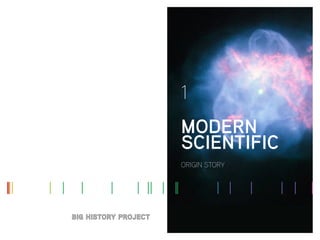
Unit 1: Origin Story: Modern Scientific
- 2. THE BIG BANG MODERN SCIENTIFIC By Cynthia Stokes Brown
- 3. 2 3 This version of modern science’s origin story is condensed and interpreted from a great body of historical and scientific information. In the beginning, as far as we know, there was nothing. Suddenly, from a single point, all the energy in the Universe burst forth. Since that moment 13.7 billion years ago, the Universe has been expanding — and cooling down as it gets bigger. Gradually energy cooled enough to become matter. One electron could stay in orbit around one proton to become an atom of hydrogen. Great clouds of hydrogen swirled around space until gravity pulled some atoms so close together that they began to burn as stars. Stars swirled together in giant clusters called galaxies; now there are galaxies num- bering in the billions. After each star burned up all its matter, it died in a huge explosion. The explosion generated so much heat that some atoms fused and got more and more complex, forming many different elements, including gold and silver. One giant star, our mother star, exploded and scattered clouds of gas containing all the elements needed to form living beings. About 5 bil- lion years ago gravity pulled these atoms into a new star: our Sun. The leftover pieces of matter stuck to each other and formed eight planets, which revolve around the Sun. The third planet out, Earth, became our home. It was the perfect size — not too big, not too small — and the perfect distance from the Sun, not too far or too close. A thin crust formed over Earth’s hot interior, and the temperature was just right for water to form on parts of the surface. Gradually the chemicals in the water formed inside of membranes and got more complex until one-celled living organisms appeared, able to maintain themselves and reproduce. For 3 billion years these one-celled creatures reproduced almost exactly, but not quite. They gradually changed in response to their environment. But they also changed their environment. They learned to burn energy from the Sun, and they released oxygen into the atmosphere. The oxygen formed an ozone layer around Earth that protected life from the Sun’s rays. Eventually certain cells combined to form multicelled creatures. Some plants and animals came out of the sea and onto land and became ever more complex and aware. Primates evolved and, hundreds of thou- sands of years ago, human beings branched from shared a shared an- cestors with the great apes. Humans could talk in symbols and sing, dance, draw, and cooperate more than the other animals could. Humans learned to write and to accumulate their learning so that it kept expanding. Humans increased in skills and in numbers until there were too many people and too few big animals in some places. Then humans learned to grow their own food and herd their own animals. Some animals learned to cooperate with humans. This gave humans new sources of food and work energy, and they could live in larger and larger groups. These groups expanded into cities and empires, using more and more of the resources of Earth. Humans col- laborated and learned collectively in more complex ways; they traveled, traded, and exchanged inventions, creating vast civilizations of aston- ishing beauty and complexity. Humans were always looking for more energy for their use. About 200 years ago we learned to use the energy from coal — trees that grew more than 300 million years ago, then were buried underground. Humans learned to burn oil — animal remains buried long ago under the sea. Using these fossil fuels, humans began to change their climate quickly, as the gases released from burning these fuels ascended into the atmosphere. Now humans are in a predicament — our population is increasing rap- idly, fossil fuels are running out, we are pushing many plants and other animals into extinction, and we are changing the climate. What are we humans going to do next?
- 4. 54 Image credits Planetary nebula NGC 6210 in Hercules Constellation © ESA/Hubble and NASA
